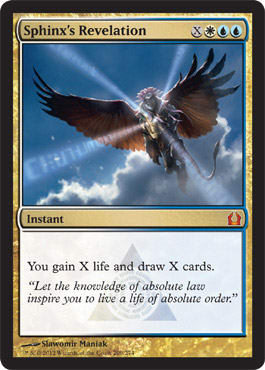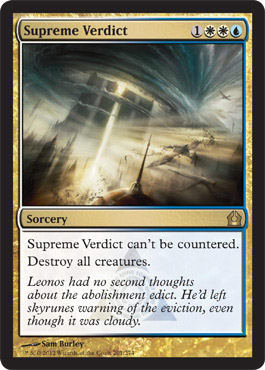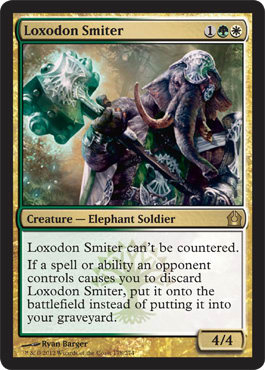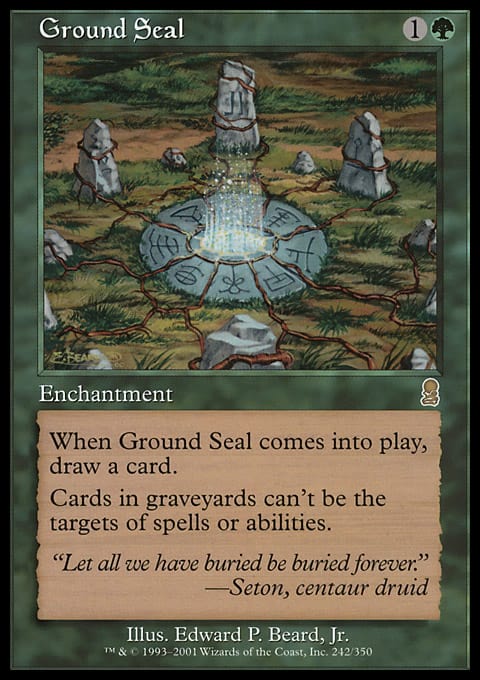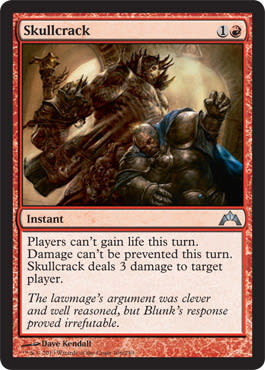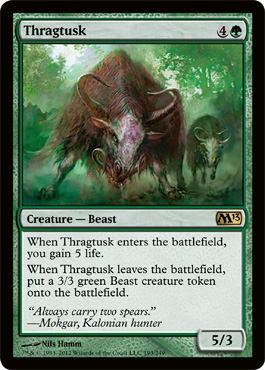Hey, everyone, long time no see!
Due to my busy school/research schedule, I haven’t had as much time to write or play Magic. That doesn’t mean I still don’t play in multiple tournaments each week, however. I’m between semesters, so this week, I get to talk about Standard. Today, I want to go over my list of Wolf Run Bant because I feel it’s criminally underplayed due to the consistency of the deck. At my local shop, Get Your Game On, I haven’t lost a match this month. I think this speaks to the strength of the spells as well as to the resilience to things such as mana screw or drawing the wrong cards at the wrong time.
Before I go any further, here’s my most recent version:
"Wolf Run Bant"
- Creatures (10)
- 3 Augur of Bolas
- 3 Restoration Angel
- 4 Thragtusk
- Planeswalkers (2)
- 1 Jace, Memory Adept
- 1 Tamiyo, the Moon Sage
- Spells (22)
- 1 Syncopate
- 2 Think Twice
- 3 Dissipate
- 4 Azorius Charm
- 4 Sphinx's Revelation
- 4 Farseek
- 4 Supreme Verdict
- Lands (26)
- 1 Island
- 1 Sacred Foundry
- 1 Steam Vents
- 2 Breeding Pool
- 2 Kessig Wolf Run
- 3 Temple Garden
- 4 Glacial Fortress
- 4 Hallowed Fountain
- 4 Hinterland Harbor
- 4 Sunpetal Grove
- Sideboard (15)
- 3 Terminus
- 3 Negate
- 1 Dispel
- 3 Loxodon Smiter
- 1 Jace, Memory Adept
- 2 Ground Seal
- 2 Rhox Faithmender
I have been very happy with this list. There are some deviations from the list popularized by Melissa DeTora in her deck from the Top 8 of Pro Tour: Gatecrash. Rather than spend this article focusing on each matchup, I want to explain the logic behind this deck and I how I think it should evolve. There are plenty of articles on this deck, and the fundamentals of each matchup have not changed.
Let’s continue by looking at Melissa’s deck so we can break down the differences:
"Melissa DeTora’s Wolf Run Bant"
- Creatures (14)
- 3 Augur of Bolas
- 3 Centaur Healer
- 4 Restoration Angel
- 4 Thragtusk
- Spells (21)
- 1 Syncopate
- 2 Dissipate
- 2 Think Twice
- 4 Azorius Charm
- 4 Sphinx's Revelation
- 3 Supreme Verdict
- 4 Farseek
- 1 Detention Sphere
- Lands (25)
- 1 Sacred Foundry
- 1 Steam Vents
- 1 Stomping Ground
- 2 Kessig Wolf Run
- 2 Sunpetal Grove
- 3 Glacial Fortress
- 3 Temple Garden
- 4 Breeding Pool
- 4 Hallowed Fountain
- 4 Hinterland Harbor
- Sideboard (15)
- 1 Centaur Healer
- 1 Detention Sphere
- 2 Garruk Relentless
- 1 Gisela, Blade of Goldnight
- 2 Negate
- 2 Rest in Peace
- 3 Rhox Faithmender
- 1 Supreme Verdict
- 2 Witchbane Orb
Overall, the deck is similar, but some key differences will affect the way you play the long game.
Planeswalkers
Sphinx's Revelation changes the way I build decks because I have to hold back in the late game so I don’t deck myself. This is clearly very powerful because I have the ability to find whatever spell I need. I can also create a toolbox-style deck to play to this advantage. At the same time, my deck could become less consistent because of all the singletons.
Melissa and I chose to keep our singletons to a minimum despite the manipulation offered by Sphinx's Revelation. You can’t count Syncopate as a singleton because it is just a cheaper version of Dissipate. The reason I have two different planeswalkers is that Sphinx's Revelation will find a second copy before I can dispose of the first.
Tamiyo, the Moon Sage is primarily used for the +1 ability, which protects loyalty. Although she is a versatile answer to such things as Nephalia Drownyard or even Thragtusk, the second copy often sits in hand. The same can be said for Jace, Memory Adept; a second copy is often not what I’m looking for once the first is in play. I have the second copy in the board should I want to aggressively find a copy.
A single copy of Jace, Memory Adept allows me to attack from a completely different angle. In three turns, I can deck my opponent from nowhere. Tamiyo can also prevent you from being decked after a series of big Revelations. If you hold a single Azorius Charm, Thragtusks can be placed on top of your deck as can Restoration Angel at the end of combat step (so they still deal damage) for enough turns to win.
I replaced Detention Sphere with Tamiyo because they perform a similar function, but they can deal with problematic permanents such as Angel of Serenity. It’s important to choose your noncreature, nonspell cards carefully because each one makes Augur of Bolas weaker.
Board Sweepers
I can’t imagine playing fewer than four copies of Supreme Verdict because the speed of Burning-Tree Emissary doesn’t allow for stumbling. It also puts you in a bad spot when you can’t kill Huntmaster of the Fells immediately because it forces you to play draw spells on your turn to avoid transforming it.
Sideboarding Terminus grants me the option to kill awkward creatures with undying, indestructibility, and regeneration. Brian Kibler always makes sure people at least think about playing green cards such as Strangleroot Geist and Predator Ooze, so we must be ready. Falkenrath Aristocrat out of the Pro Tour–winning deck, The Aristocrats, presents another dynamic threat that must be answered.
Not only are there plenty of threats in the format that dodge Supreme Verdict, but there are matchups such as G/W aggro and Naya Blitz that demand additional sweepers. If you’re on the draw, there are few answers to the speedy starts provided by Burning-Tree Emissary, and Terminus allows for faster responses via miracle.
Centaur Healer Versus Loxodon Smiter
Melissa chose to play Centaur Healer while I have recently switched to Loxodon Smiter. To mix it up even further, I don’t play either in my main deck. I don’t want to play creatures that simply attack and block in my main deck because Standard decks pack too much removal Game 1. After sideboard, both of these creatures become better because the opponent makes room for control-hating cards by cutting removal.
I prefer Loxodon Smiter because it can be a great foil to Liliana of the Veil and Rakdos's Return out of Jund. Last week, I discarded the Smiter to Liliana on turn three, which ended very well for me.
If you notice the large number of counters in the sideboard, boarding Smiter against slower decks will make more sense. I have tried to fight Esper control by adding counters and playing the long game, but Esper has Duress and Nephalia Drownyard, so that deck is advantaged. I like to play a fish-style strategy by casting Smiters and Angels backed up by counters.
Against Jund, you will need additional threats after your Thragtusks are inevitably taken by Slaughter Games. The 4/4 body can take down Beast tokens and both parts of a Huntmaster of the Fells.
I like Smiter against aggressive decks, too. I don’t want my creature to die to Flinthoof Boar or Hellrider. There are so many ways to gain life that cutting one source hasn’t been an issue for me. I have had about six games in which I ended above 60 versus Red Deck Wins variants.
Witchbane Orb
I don’t like this card anymore because it has become expected. Can you risk resolving this on turn four against Jund to protect from Slaughter Games? I think the possibility of facing down a Garruk, Primal Hunter is too great of an issue. How about waiting until turn six to leave up Negate? The opponent has already played Slaughter Games, and your Thragtusks or Sphinx's Revelations have been taken.
Ground Seal Versus Rest in Peace
If Human Reanimator combo is big in your area, feel free to keep Rest in Peace. In most areas, Junk Reanimator is a huge force, and that deck doesn’t actually care that much about Rest in Peace. I say this because Thragtusk and Angel of Serenity can still serve up some beats.
If I spent time preparing for a tournament with Junk Rites, I would be more than aware of the likelihood of facing Rest in Peace. Many Reanimator players ignore the graveyard after sideboard, which makes an enchantment that doesn’t cycle much worse by siding out Unburial Rites. Another option for Reanimator is to bring in Abrupt Decay or Acidic Slime. I would rather have my cantrip destroyed.
The sideboarding implications of Rest in Peace also make me worried about playing it when I don’t have to. Think Twice is not bad against Reanimator because so many counters come in after board. When I have Rest in Peace in play, the flashback becomes useless. Ground Seal plays with your spells nicely because nothing in the deck targets cards in the graveyard.
I would also sideboard in Ground Seal against Prime Speaker Bant as well as Big Naya because it stops Angel of Serenity from bringing back giant monsters. Since Rest in Peace is not what you want against a single threat, Ground Seal is a realistic option.
Quick Sideboarding
Everybody loves a good sideboarding breakdown against the big matchups, so here it is:
Jund:
+3 Negate
Esper:
+1 Dispel
+3 Negate
Naya Blitz:
+3 Terminus
−3 Dissipate
−1 Syncopate
−2 Think Twice
Junk Rites:
+2 Ground Seal
+3 Negate
Rant on Over-Sideboarding and Skullcrack
I have encountered many players with RDW who seem to think Skullcrack is awesome against me because of Sphinx's Revelation and Thragtusk. This card may seem as though it’s powerful against me because it was tailor-made to beat those problematic spells, but this is just not the case. Do you want to know a secret? I actually want you to play this card against me.
The fact that I take a functional 8 damage (3 damage plus 5 life-gain prevention) from a Thragtusk, I still have a 5/3 that can be blinked by Restoration Angel. In addition, you have effectively mulliganed because that is one fewer creature in your hand. All I want to do against RDW is kill your creatures because they are recurring sources of damage.
What if you deal me 9 theoretical damage on a Sphinx's Revelation for 6? That means I get to untap with 6 extra cards in hand and probably resolve a Thragtusk and gain 5 life. It also means I probably drew another Revelation that will actually gain me 7 to 8 life and put the game completely out of reach.
Why even bother trying to fight Bant control on this axis? I’m still wondering this because RDW owns the early game, and I own the late game. Adding Skullcrack to your deck means you are trying to still kill me in the early game, but you have fewer threats to work with. If I take the game to turn ten, it’s highly likely I win the game.
I have played against Skullcrack about ten matches in the last six weeks, and I have never lost a game in which it was cast. This suggests there should be a different card in the sideboard against Sphinx's Revelation and Thragtusk.
This brings me to the other issue surrounding red decks: over-sideboarding.
Players are interested in sideboarding in Skullcrack and Boros Charm against me, and I don’t understand it. By dedicating so many slots to reactive spells, you are unintentionally dragging out the game by having fewer creatures in your deck. Standard has a low number of powerful burn cards, which makes them very weak against control. If you have to leave up 2 mana to counter my Supreme Verdict, I have fewer threats to worry about.
The best way to actually combat control decks is to ignore what I’m doing. I don’t try to attack you with my creatures because they are supposed to block against aggro. It seems very obvious when I say this because I play the control role. It is less understood that the aggro deck should not be trying to control the game against Sphinx's Revelation by playing Boros Charm and Skullcrack. The best way to fight control is to play creatures and threats that attack from different angles, such as Domri Rade (that card blows out Azorius Charm).
Conclusion
Because it plays card-drawing spells and plenty of land sources, Bant has proven to be a very consistent choice for Standard. I love being able to play a fun control deck that also has two of the strongest cards in the format (Revelation and Thragtusk).
This deck has been underplayed, and it is a great time to strike. Games I have lost can be directly attributed to mistakes made by me, which I think shows that the deck is a good choice.
Thanks for reading, and please let me know in the comments if you liked this style of breakdown.
–Kyle













